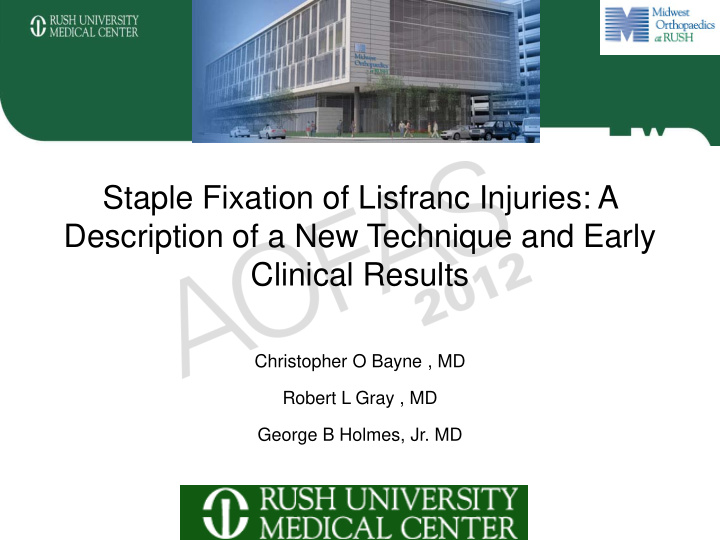



Staple Fixation of Lisfranc Injuries: A Description of a New Technique and Early Clinical Results Christopher O Bayne , MD Robert L Gray , MD George B Holmes, Jr. MD
Disclosures Christopher O. Bayne , M.D My disclosure is in the Final AOFAS Program Book. I have no potential conflicts with this presentation. Robert Gray, M.D. My disclosure is in the Final AOFAS Program Book. I have no potential conflicts with this presentation. George B. Holmes, Jr. MD: My disclosure is in the Final AOFAS Program Book. I have a potential conflict with this presentation due to: I have received royalties and consulting fees with respect to the Mini Tightrope(Arthrex).
Introduction Lisfranc Injuries Treatment goals • Anatomic reduction of tarsometatarsal joint, • Stable fixation to allow for ligamentous healing • Preservation of articular cartilage of Lisfranc joint • Maintenance of physiologic Lisfranc joint motion • Fixation that does not irritate adjacent soft tissues and nerves • Fixation that resists failure and breakage
Study Design Retrospective case series of 8 patients with Lisfranc injuries treated operatively utilizing pneumatic staple fixation between 2004 and 2009
Materials and Methods • 12 consecutive patients with Lisfranc injury (between 2004 and 2009) • Operative treatment utilizing pneumatic staple fixation •SMFA and SF-36 questionnaires administered via telephone interview (at minimum 24 mos fu) •Literature search -all previous studies examining SMFA and SF36 results after operative fixation of Lisfranc injuries identified. •Questionnaire results from study compared to results found in the literature
Results 8 patients available for interview at follow-up. •4 patients treated with staple fixation alone •2 patients treated with combination of staples and mini- suture button •1 patient treated with combination of screws and staples •1 patient treated with combination of screw, K-wire, staple, and mini suture button
Results Literature search: •3 studies utilized the SF-36 questionnaire 1-3 •1 study utilized the SMFA questionnaire 1 ( To evaluate functional health and well being in post- operative Lisfranc patients )
Results •Patients in staple fixation group scored better in all categories on both the SMFA and SF36 questionnaires Group SMFA SF-36 (mean score) (mean score) Staple Fixation 11.8 73.8 Literature 17.3 48.6
Discussion Better scores may be due to properties of staple fixation: • May allow for enough rigidity for ligamentous healing • Without violating articular surfaces • Without limiting all motion • Staples are low profile • Less symptomatic hardware • May decrease need for later removal compared to plates
Conclusion • This study presents preliminary results of post-operative functional health and well being following technique of staple fixation of Lisfranc injuries. • Despite the small number of cases, we believe that the functional outcomes are encouraging and warrant further investigation. REFERENCES 1. Henning JA, et al. Open reduction internal fixation versus primary arthrodesis for lisfranc injuries: a prospective randomized study. Foot Ankle Int 2009 Oct;30(10):913-22 2. O'Conner PA, et al. Lisfranc Injuries: patient and physician-based functional outcomes Int Orthop 2003;27(2):98-102 3. Schepers T, et al. Pedobarographic analysis and quality of life after lisfranc fracture dislocation. Foot and Ankle International 2010 Oct;31(10):857-64 4. Coetzee. Making sense of lisfranc injuries. Foot Ankle Clin (2008) vol. 13 (4) pp. 695-704 5. Ly et al. Treatment of Primarily Ligamentous Lisfranc Joint Injuries: Primary Arthrodesis Compared with Open Reduction and Internal Fixation. A Prospective, Randomized Study. The Journal of Bone and Joint Surgery (Am) (2006) vol. 88 (3) pp. 514-520 6. Rammelt et al. Primary open reduction and fixation compared with delayed corrective arthrodesis in the treatment of tarsometatarsal (Lisfranc) fracture dislocation. The Journal of bone and joint surgery (Br) (2008) vol. 90 (11) pp. 1499-506
Recommend
More recommend